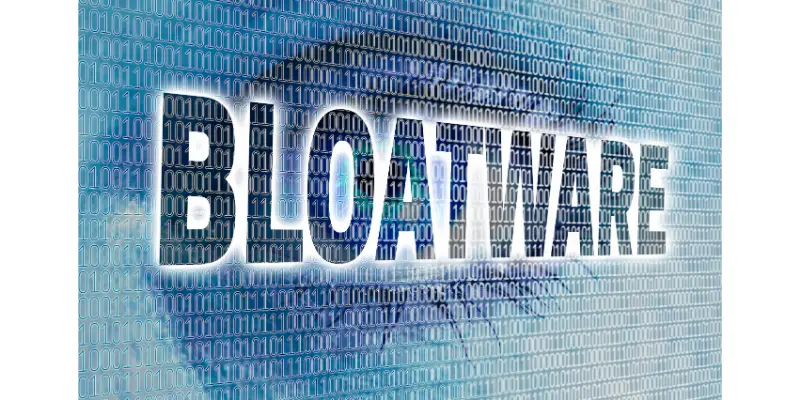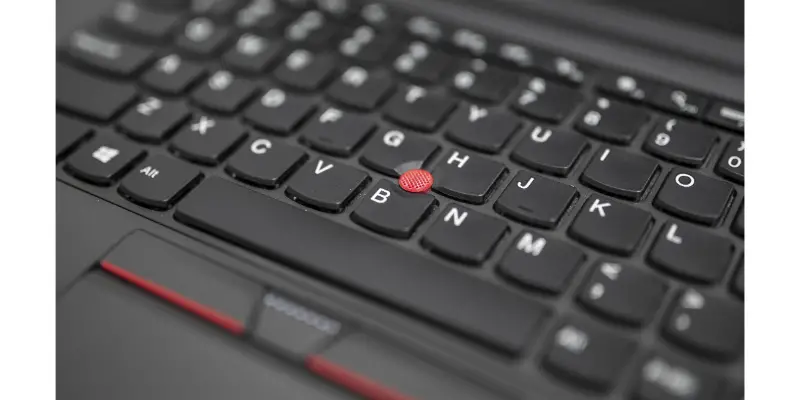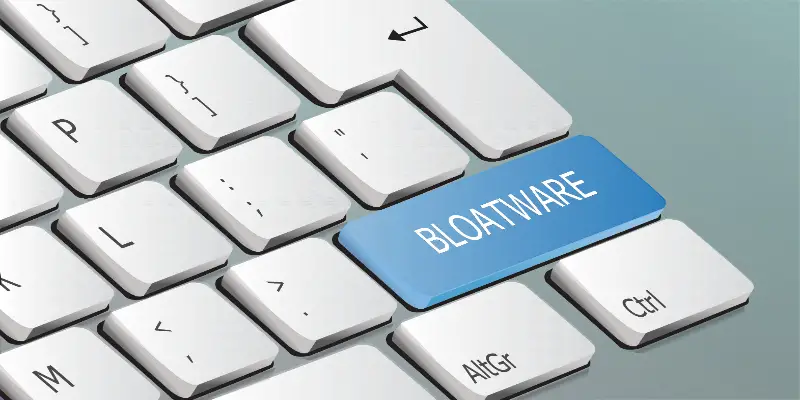Disclaimer: This post may contain affiliate links, meaning we get a small commission if you make a purchase through our links, at no cost to you. For more information, please visit our Disclaimer Page.
Lenovo is still one of the most popular laptop manufacturers on the market as the company has held about 25% of the market share for laptops in the first quarter of 2021. But while Lenovo is one of the biggest laptop brands on the market, a historical problem regarding Lenovo laptops is that they tend to have bloatware. Even though Lenovo has improved a lot in the past few years, do Lenovo laptops still have bloatware?
Yes, Lenovo still has pre-installed programs that are often considered bloatware. While some bloatware can be useful, most of them can slow down or even harm your Lenovo laptop. That’s why, if you do detect or find bloatware in your Lenovo laptop, you can actually remove them yourself.
Bloatware is quite common in laptops no matter which manufacturer you are talking about. But the problem here is that Lenovo has earned a pretty bad reputation in relation to the company’s laptops because of how they have a lot of bloatware. So it is necessary for you to know how to remove such bloatware so that you can speed up your Lenovo laptop or free up some space.
Table of Contents
How do I know if my laptop has bloatware?
OEM laptops purchased from various firms or manufacturers typically come pre-installed with some of the most helpful applications that you will require to run your system effectively. Examples include the operating system itself, office tools (such as Microsoft), and other comparable applications and apps that you may use on a daily basis whenever you use your laptop, eliminating the need to download or purchase them individually.
But the problem when it comes to OEM laptops that come pre-installed with Windows is that they will most likely come with what we call bloatware. Some people may not be familiar with that term but bloatware is actually commonly used in the computer world especially when it comes to OEM computers that come from different manufacturers.
Basically, bloatware is the term that is used to describe different unnecessary software that are pre-installed in OEM computers such as laptops. And what we mean by “unnecessary” is that they don’t actually help the performance or the functionality of the laptop. Instead, they essentially make the laptop “bloated” in the sense that they will take up unnecessary storage space and may even slow the laptop down because they automatically launch as background apps or processes that will eat up valuable memory.
That said, it really isn’t uncommon for laptop owners to notice that their laptops are not functioning as efficiently as they are supposed to. And you can most likely point the fingers at the pre-installed bloatware that comes with the laptop.
While there really is no clear consensus on how much bloatware can slow your laptop down, the general belief is that they do slow the computer down and that they may actually cause more harm than good down the line depending on what kind of bloatware you are talking about. But how do you even tell if your laptop has bloatware?
Essentially, if you want to know if your laptop has bloatware, the only way for you to do so is to actually search your laptop thoroughly. In most cases, you can easily do that by looking at all the installed apps or programs on your laptop. You will be able to identify the bloatware if you detect apps or programs that you actually did not install and are not using regularly. And you can also classify software that you were not informed of when you purchased the laptop as bloatware.
Another way for you to detect if there is bloatware taking up important memory space from your laptop is to open your task manager by pressing on CTRL + ALT + DEL. When the task manager is already open, what you need to do next is to go to the processes tab.
In the processes tab on your task manager, you will see all the processes that are operating in the background. A lot of these processes are very important for your laptop to function normally but you may be able to detect some processes that you are not familiar with and are not quite important for your laptop. This can include adware and software tools that you may not be using but are still operating in the background and are automatically opened the moment you start your laptop up.
There may be some software tools that you can use to clean your computer up such as CCleaner but they aren’t really necessary for you to detect bloatware in your laptop. In most cases, software cleaners may also end up becoming bloatware that will take up valuable memory space. Again, CCleaner can be a good example because it automatically operates as a background process.
Do Lenovo laptops have bloatware?
Now that you know more about what bloatware is and how to tell whether or not your laptop does have bloatware, you may wonder whether Lenovo laptops do come pre-installed with bloatware that can annoy and may end up hindering their performance. So, do Lenovo laptops have bloatware?
Unfortunately, yes, Lenovo comes with plenty of bloatware that will possibly slow down your laptop. Bloatware might be quite common in OEM laptops but it actually is more common than you think for Lenovo laptops. Lenovo has often gotten negative comments from users precisely because of how the company’s laptops usually come with plenty of bloatware, which comes in the form of software that they pre-installed but are actually pretty useless to most users and may even end up slowing the computer down.
The most common bloatware comes as software that Lenovo believes should be useful for Lenovo laptop owners but actually aren’t quite as useful as they think. The bloatware programs are usually that are proprietary owned by Lenovo such as the Smile Dock, which is supposed to allow the user access to quick web searches. But such software isn’t really necessary and will only take up valuable storage and memory space from your laptop.
Even something as simple and common as QuickTime, which is available in most Windows laptops and not just in Lenovo computers, can be classified as one of the most annoying bloatware for Lenovo laptop users. While QuickTime has some uses, the problem is that it tends to take up RAM space because it runs as a background program in most laptops and may even annoy people when it automatically runs its update app. And, most of the time, people use other video playback options other than QuickTime.
Another issue with Lenovo bloatware is that some of it may potentially damage your laptop’s security simply by existing on your laptop. Regardless of whether you actually use such software, they end up becoming bloatware because they can be harmful to your computer.
One of the many vulnerabilities in Lenovo’s bloatware can be found in its very own UpdateAgent, which is supposed to actually make it easier for you to update your Lenovo laptop and all of the different software installed in it.
The issue with the Lenovo UpdateAgent is that it does not give any security features while updating some of the software on your laptop. As UpdateAgent operates and updates the software on your laptop, the agent’s calls are not encrypted and lack security measures that ensure the connection between your laptop and the internet is safe and secure. That means that UpdateAgent’s calls can be readily intercepted by anybody with bad intent.
In that regard, when there is a remote attacker who might want to exploit the vulnerability in Lenovo’s UpdateAgent, he can easily take control of the system and use it to his advantage. It is needless to say that this will be to your disadvantage because important data and vulnerable personal information may be used against you.
That is why is highly advisable that you actually uninstall Lenovo UpdateAgent when you own a Lenovo laptop that comes with this app or software. But Lenovo UpdateAgent isn’t the only problematic bloatware that has been found in Lenovo laptops.
What was the Superfish scandal?
We can complain about all the different bloatware that we can find in a Lenovo laptop but nothing can ever top the Superfish scandal that happened during the earlier half of the last decade. But what exactly is the Superfish scandal?
In 2014, plenty of different Lenovo laptop and computer users have started to complain about Superfish because they thought it was annoying and how it has made them more concerned with their security. In 2017, the company paid a $3.5 settlement with state attorney generals. But, before we get there, what exactly is Superfish?
Superfish is a tool that Lenovo used to pre-install in their OEM laptops. It is owned by a firm located in Tel Aviv and Palo Alto. The goal of installing Superfish in Lenovo laptops was to give Lenovo control over the Google search advertising that its consumers view. So, everytime you do a Google search, Superfish adjusts it somewhat based on what Lenovo wants you to see since they are most likely generating money from the product advertising that appear when you do a basic search.
When people started complaining about Superfish, a Lenovo spokesperson spoke out and said that Superfish only uses images on the web to try to present you with similar products that are on the more affordable side of the spectrum instead of using your behavior or personal data when you are making internet searches. So, basically, what Lenovo was saying is that Superfish is not tracking your behavior or even record your personal information but is only using the images of your search results to present you with identical products that should allow you to save more money.
Lenovo also said that you are actually given the choice to enable or disable Superfish because you are asked to accept the End User License Agreement at the start. Agreeing to it will allow Superfish to do what it is supposed to do while disagreeing with it will essential disable Superfish.
While Lenovo’s statement regarding Superfish sounds innocent, the problem that privacy advocates have found is that Superfish uses your internet traffic and may actually abuse it to some extent especially if you are not using an encrypted connection.
But the bigger problem here was that Lenovo essentially interrupted the certificate chain by pre-installing Superfish into their laptops. Basically, the certificate chain is a chain of trust in the sense that the companies who run the computers and machines that users have to go through when they visit certain websites actually need to present certificates to the user to prove that they are not legitimate and are not planning anything malicious on their part.
However, it was claimed that Lenovo actually signed the certificate itself in relation to Superfish so that Superfish will appear as a trusted party on your computer without your consent on the matter. Because of that, Superfish is able to see your internet traffic and use it to its advantage and may even alter it. So because of this, Superfish becomes the authoritative figure with deciding which communications to trust even if you are about to enter a website that normally shouldn’t be trusted.
While Superfish isn’t necessarily going to do anything malicious with that or with your personal data, it still isn’t ideal for them to have such authority over your laptop. That’s because Lenovo can easily abuse this and make use of it as a way to spy on Lenovo laptop users. This is not to say that Lenovo has any plans on doing that but it still is better to be safe than sorry when it comes to your privacy and your own personal data.
But while not a lot of people are concerned about what Superfish and Lenovo could do regarding your data because of how they are given the benefit of the doubt as legitimate companies that will try their best to value whatever private information they have of you, the dangerous part here is that anyone who can possibly extract the private key that Superfish is using can use it to their advantage.
This can happen when you are sharing the same network as a hacker and that hacker uses the private key that Superfish is using to sign their own certificates so that they can use the network to spy on Lenovo laptop users who are connected to the same network.
Think about this scenario. Let’s say you handed over the keys to your house to someone you trust who won’t do anything bad with it. However, he leaves the keys out in public so that someone might make a copy out of it and use the key to enter your home. The same scenario could happen in relation to Lenovo and Superfish and what malicious hackers could do with the private key.
While this isn’t the easiest thing to do even for the most gifted hackers, it still is possible for a malicious hacker to extract the key and make use of it to extract valuable information from Lenovo laptop users such as their personal data, bank accounts, and social media passwords. This makes it easier for us to understand why the Superfish scandal was such a big deal.
Does Lenovo still use Superfish?
So, in case you are using a Lenovo laptop right now, you might wonder about Superfish and whether your laptop has Superfish on it. The good news, however, is that you don’t have to worry. That’s because Lenovo only installed Superfish on laptops between September and December 2014.
Aside from that, since the scandal blew up, Lenovo immediately took Superfish out of their consumer laptops while also taking it offline. Meanwhile, Superfish has also disabled Lenovo computers from activating Superfish. That means that Lenovo no longer uses Superfish.
Still, if you are concerned about this scandal and whether or not your Lenovo laptop is affected, you can try to locate Windows’ list of trusted certificates in your Control Panel and by searching “certificates” there. Once you do so, you will be directed to Administrative Tools where you will see an option that will allow you to manage the certificates on your computer.
After that, you need to click on the Trusted Root Certification Authorities option to see Certificates. And if you see Superfish Inc. there, then that means that your Lenovo laptop is affected by this bloatware.
Which laptop has the least bloatware?
With laptops, choosing a laptop that comes from one of the bigger companies will almost always ensure that the laptop will come with bloatware. That’s because these companies install their own proprietary software as a means for you to use the laptop according to how they want you to use it such as when you are using Lenovo’s Smile Dock.
This can be good branding for the company but it won’t always guarantee better performance on the part of your computer or more efficiency on your part. This often leads a lot of laptop owners to reinstall their operating systems the moment they bring home an OEM laptop so that their laptops come with a fresh OS with no bloatware installed.
However, if you are looking for a good laptop that doesn’t come with a lot of bloatware and will only come with the necessary software you need to run the laptop, then we suggest you choose Microsoft laptops.
The reason Microsoft laptops don’t come with plenty of bloatware is that they are actually the ones behind the Windows OS that you are using and that all the different software that are pre-installed in the laptop are the essentials that you will need when you are using a Microsoft laptop. That said, if you don’t want to end up reinstalling your OS, you might want to use a Microsoft laptop instead.
Which bloatware should you remove and which you should keep?
If you have a Lenovo laptop and you are deciding which among the bloatware you should remove and keep, here is a quick table of the most common Lenovo bloatware:
| Software |
Remove/Keep |
| Smile Dock | Remove |
| Idea Notes | Remove |
| Power2Go | Keep |
| Lenovo Registration | Keep |
| YouCam | Keep |
| Energy Management | Keep |
| UpdateAgent | Remove |
| Superfish (if present) | Remove |
| PowerDVD | Remove |
| Quicktime | Remove/Disable |
Conclusion
A lot of people tend to think that the bloatware or additional pre-installed software that comes with their Lenovo laptops are safe. While some of them are safe, you should still be concerned about some of the security risks that come with them such as Superfish and UpdateAgent for the reasons we stated above.
And even if some bloatware are actually safe, they can still end up slowing your computer down or taking up valuable storage space. After all, some bloatware tends to operate as background processes and may eat up storage space that you could have saved up for some of the more important software you need.
Conclusion
As such, it is best to know what is in your Lenovo laptop if you want to get the most out of the money you paid for it. Always think about the fact that this is your laptop and is not owned by Lenovo. That is why you need to take control over it and remove anything that you will not find useful so that you can make sure that every bit of space and memory are reserved for what you actually find important and useful.




